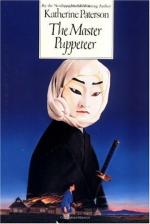
|
| Name: _________________________ | Period: ___________________ |
This test consists of 5 short answer questions, 10 short essay questions, and 1 (of 3) essay topics.
Short Answer Questions
1. What does Jiro offer to do for Kenshi?
2. Who saves Jiro from a ronin?
3. Who is Mochida?
4. How does Jiro do in his part of the play?
5. Who offers the reward for Saburo's capture?
Short Essay Questions
1. What do Saburo and his gang do one evening?
2. Why is Jiro almost attacked and who saves him?
3. What does Isako bring to the theater and what does she tell Jiro?
4. What does Jiro admire about one of Yoshida's apprentices?
5. How do some of the attendees feel about the resemblance of Joman to Saburo?
6. What does Kinshi steal for a celebration and what happens?
7. What do Jiro and Kinshi think of Yoshida's performance?
8. What does Jiro decide to do and why does he make this decision?
9. What is the basic plot of the play?
10. Who are the other apprentices?
Essay Topics
Write an essay for ONE of the following topics:
Essay Topic 1
Discuss the following:
1. What do you think are the characteristics of a successful novel?
2. Analyze and discuss The Master Puppeteer based upon the criteria you decide upon in #1 and judge if The Master Puppeteer is a successful novel.
3. Do you think the criteria for a successful novel should be different if it is written for adults versus young adults? Why or why not? Would most adults consider The Master Puppeteer a successful novel? What about young teens?
Essay Topic 2
Over the course of The Master Puppeteer, Jiro grows as a person in both complexity and understanding. The Master Puppeteer might be considered a slice of Jiro's larger story of his "coming of age." It might be said that The Master Puppeteer is a "bildungsroman" of Jiro. Discuss the following:
1. Define Bildungsroman, or "Coming of Age," and give several examples from literature you have read.
2. Trace and analyze the character of Jiro as he changes from a more carefree, innocent boy to a wiser, young man. What are the significant events that change Rick?
3. After thoroughly analyzing Jiro's growth throughout The Master Puppeteer, do you think The Master Puppeteer could be considered Jiro's Coming of Age story? Why or why not?
4. Are there any other characters in The Master Puppeteer who go through a Coming of Age experience? Who? Why do you think so?
Essay Topic 3
Characters are an integral and important part of almost all novels. Discuss the following:
1. Compare/contrast the characters of Jiro and Kinshi. How are they similar? How are they different? Is there a flaw in each of their personalities? Be specific and give examples.
2. Compare/contrast the characters of Saburo and Kinshi. How do they seem different? Which do you like more? Why? Which one seems more of a well-rounded character?
3. Thoroughly analyze how three of the secondary characters in The Master Puppeteer help drive the plot and what their contribution is to the storyline. Are any of the secondary characters unnecessary? Indispensable? Which of the secondary characters are likable? Which are either unlikable or even despicable? Be specific and give examples.
|
This section contains 1,023 words (approx. 4 pages at 300 words per page) |

|




